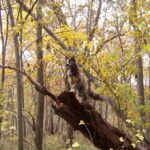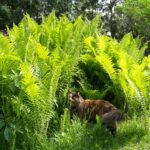by Winding Pathways | Mar 11, 2021 | (Sub)Urban Homesteading, Birds, Pests
Millions of people love their cats. Some 36% of households keep an average of two cats. They are the second most popular companion animal in the United States, lagging only behind dogs.

Cats decimate bird populations.
Some cats cause problems, especially when owners allow them to free-range the neighborhood. According to the American Bird Conservancy, they kill 2.4 billion birds a year and may be a significant cause of the decline of many species.
Catios to the rescue!
A growing number of cat lovers, many who also enjoy bird watching, recognize the problem and are increasingly adding a catio to their home. Wonder what it is???? It’s simply an enclosure that allows the family cats to enjoy fresh air, sunshine, and a bit of adventure without allowing them complete access to the neighborhood.
Many catios are enclosed patios, which spawned the name, that let cats play outdoors while their owners enjoy lounging or socializing nearby. They are relaxing places for both species. Other catios are small and positioned outside windows. Catios can be either purchased or homemade and often an existing patio can be modified into one.
Safety First!
Although cats love roaming the neighborhood, it is not a safe place. They pick up ticks and transfer them to humans, suffer accidents, are killed by cars as they cross streets, and are taken by predators.
A catio is a good solution to several problems. It allows cats to enjoy the outdoors safe from cars and predators in a place where they can’t kill birds. And, the owners always know where their cat is.
Harmony
An array of catio photos is visible on Catio Spaces. Many other websites feature them. Catios are a great way for cat lovers to show care of wildlife species, keep their cats safe, and live in peace with human neighbors who are frustrated when they spot a feline stalking birds under their feeder.
by Winding Pathways | Jul 9, 2020 | (Sub)Urban Homesteading, Garden/Yard
One morning while watching the arrival of spring migrant birds, we were startled and annoyed to see a cat lurking under the feeder seeking a bird victim. We so enjoy the Summer and Scarlet Tanagers, and Indigo Buntings at our feeders. They add diversity to our usual visitors – titmice, chickadees, cardinals, and woodpeckers who visit throughout the year.
We chased the cat away but began researching the history of domestic cats and their impact on wildlife. It’s both fascinating and concerning.
Challenges Facing Birds
Modern birds face many challenges, including habitat destruction, climate change, light pollution that disrupts navigation, and crashing into towers. However, the International Union for Conservation of Nature lists domestic cats as one of the world’s worst nonnative invasive species. They are the number one human-caused threat to birds in the United States and Canada and kill upwards of 2.4 billion a year.
Domestication of Cats

Cats have a strong hunting instinct.
People and cats have a long relationship. They were domesticated from the European wildcat over 10,000 years ago, probably in the Fertile Crescent. Wherever people have migrated to they’ve brought along cats. Even after so many years living with people this animal, Felis sylvestris, retains its predatory instincts, reproduces rapidly, and readily goes wild, or feral.
Domestic cats are fascinating animals loved by millions of people, so any criticism of them often brings a sharp emotional response. However, there’s no doubt they harm wildlife, and one of the main reasons is their artificial high population density.
Animal Territories
Wild predators, like cougars, bobcats, and wolves have vast territories. It takes plenty of land to sustainably produce enough prey for a predator to live. So, if they are crowded together they’d starve. A naturally occurring population of predators in a healthy ecosystem simply has few individuals. For example, a healthy population of native bobcats may have only a few individuals spread over several square miles. The same goes for wild native European wildcats in natural areas in Asia and Europe. The problem comes when humans crowd many cats into a small area.
Families that don’t want cats stalking birds can take a few actions to reduce the death toll of birds. These include:
- Asking neighbors to keep their animals in their home or yard.
- Placing feeders on metal “shepherd’s hooks” that cats can’t climb.
- Configuring a ring of wire mesh around feeding stations to exclude cats from catching juncos, chipping sparrows, and other ground-feeding birds.
Birds face many hazards in this modern world. Cat predation is one that can be reduced. Both cats and birds can enjoy a safer life if the owners of descendants of the European wildcat kept their pets indoors.
by Winding Pathways | Feb 20, 2017 | Birds, Nature, Pests
A recent article in LIVING BIRD Magazine reported that cats kill more than 2.4 billion birds each year in the United States. Their numbers came from the book, CAT WARS, by Peter Marra and Chris Santella.
use cats are fascinating animals that are loved by 600 million people worldwide who keep one or more as pets. They’ve been part of the human experience since at least the dawn of agriculture. Descended from a species that remains wild in Saudi Arabia, Israel, and other Middle Eastern countries, cats were informally domesticated as early as 10,000 years ago. Probably the earliest semi tame cats were wild individuals who lived near cultivated fields and hunted mice and other pests. At some point people began taking them into their homes as pets.
House cats followed humans as they spread around the globe and today are common wherever people live. Unlike many domestic animals that long ago lost their ability to survive in the wild, cats often go wild. These “feral” animals have a high reproductive rate and can create a large wild population in a relatively short time. Often these colonies of feral cats prey on animals that have no defense against them.
Cats never lost their ability to hunt and continue to catch animals, especially mice and other small mammals. Unfortunately they are also effective bird predators. Cats kill more birds than collisions with buildings, power lines, and wind turbines combined. They pose a serious threat to some bird populations.
There is a simple way that cat lovers can enjoy their pet while reducing the impact of these fascinating animals on birds…….keep them indoors.
For more information:
Cat Wars: The Devastating Consequences of a Cuddly Killer. Princeton University Press.
The Cornell University Laboratory of Ornithology.
*Note: Winding Pathways is not paid by companies we feature.


